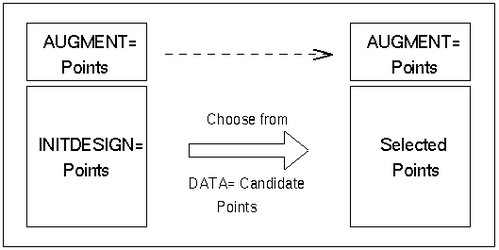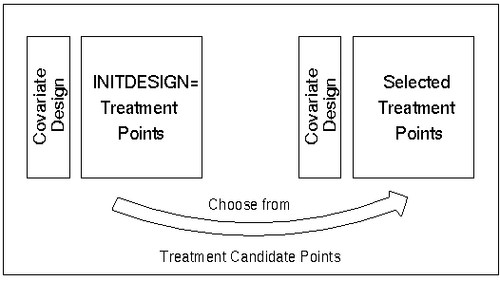Input Data Sets
This section discusses the five input data sets for the OPTEX procedure. Three of the data sets provide points used to generate the design according to the effects you specify in the MODEL statement. Two other data sets provide points used to generate a model for fixed covariates.
Only the DATA= data set is required. If you do not specify a DATA= data set in the PROC OPTEX statement, the procedure uses the last data set created as a set of candidate points for the design. The AUGMENT= data set is optional and contains points that are guaranteed to be included in the final design. The INITDESIGN= data set is also optional and provides an initial design to be used by a search procedure. Variables listed in the MODEL statement must be present in all three of these data sets, and the variable characteristics (type and length) must match across data sets.
Figure 14.6 is a schematic diagram of the roles of the DATA=, AUGMENT=, and INITDESIGN= data sets in constructing the design. Figure 14.7 presents the role of the DESIGN= data set for block designs.
Figure 14.6: Choosing from DATA= Points

Figure 14.7: Choosing Treatment Candidates

DATA= Data Set
The DATA= data set provides a set of candidate points used to create a design. The OPTEX procedure uses the variables listed in the MODEL statement when creating a design.
The effects specified in a MODEL statement determine the variables used when generating a design. For example, if the DATA= data set contains the variables A, B, and C, but the MODEL statement specifies effects involving only A and B, then the variable C is not considered when generating designs.
Variables in the DATA= data set that are listed in the ID statement are transferred to the OUT= data set (if one is created).
AUGMENT= Data Set
The AUGMENT= data set provides a set of points that must be included in the final design. The OPTEX procedure adds candidate points from the DATA= data set to the points from the AUGMENT= data set when generating designs. The number of points in the AUGMENT= data set must be less than or equal to the number of points for the design (either the default or the number specified with the N= option in the GENERATE statement).
As with the DATA= data set, the effects specified in a MODEL statement determine the variables used when generating a design. The types and lengths of variables in an AUGMENT= data set that are used in the MODEL and ID statements must match the types and lengths of the same variables in the DATA= data set. If you use an ID statement and the AUGMENT= data set contains the ID variables, these variables are transferred to the OUT= data set (if one is created). See the section Including Specific Runs for an example that uses an AUGMENT= data set.
INITDESIGN= Data Set
The INITDESIGN= data set provides a set of points that are used as an initial design in the search for an optimal design. These points are not necessarily contained in the final design. The OPTEX procedure uses these points to begin the search for an optimal design. The number of points in the INITDESIGN= data set must be the same as the number of points in the design (either the default or the number specified with the N= option in the GENERATE statement).
As with the DATA= data set, the effects specified in a MODEL statement determine the variables used when generating a design. The types and lengths of variables in an INITDESIGN= data set that are used in the MODEL and ID statements must match the types and lengths of the same variables in the DATA= data set. If you use an ID statement and the INITDESIGN= data set contains the ID variables, these variables are transferred to the OUT= data set (if one is created). See Example 14.3 for an example that uses an INITDESIGN= data set.
If you use an INITDESIGN= data set and also specify METHOD=SEQUENTIAL in the GENERATE statement, no search is performed (you do not have to specify ITER=0 in this case). The INITDESIGN= data set is the final design. In this way, you can use the OPTEX procedure to evaluate an existing design.
BLOCKS DESIGN= Data Set
The DESIGN= data set in the BLOCKS statement contains a set of points that are used to generate a model for fixed covariates. These points are contained in the final design and are transferred to the OUT= data set (if one is created). See Example 14.8 for an example that uses a BLOCKS DESIGN= data set.
BLOCKS COVAR= Data Set
If you specify a COVAR= data set in the BLOCKS statement, the observations for the variables listed in the VAR= option are used to define the assumed variance-covariance matrix for the experimental runs. These observations are not transferred to the OUT= data set (if one is created). Note that since covariance matrices are necessarily square, the number of observations in the COVAR= data set must be the same as the number of variables listed in the VAR= option. See Example 14.9 for an example that uses a BLOCKS COVAR= data set.